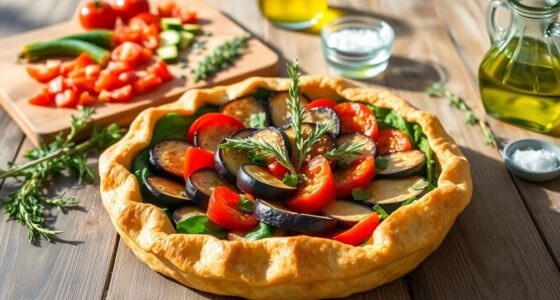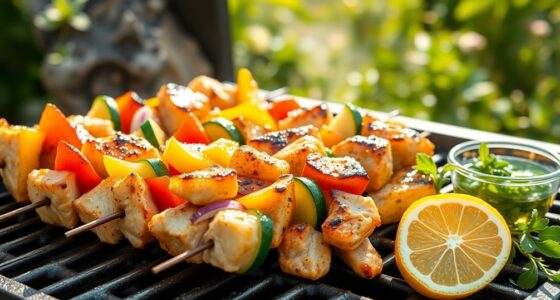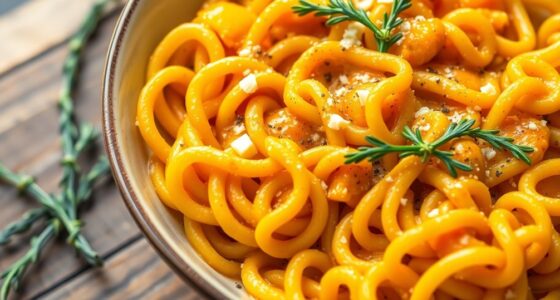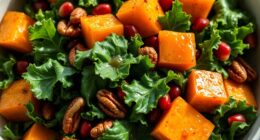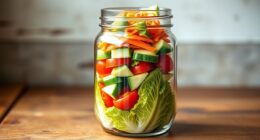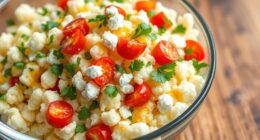Baked vegetable pasta is a comforting dish that combines roasted seasonal veggies, cooked pasta, and marinara sauce for a hearty meal. It's perfect for family gatherings, minimizing food waste while packing in flavor and nutrients. You can customize it to fit dietary needs, using whole grain or gluten-free pasta if preferred. Topped with melted cheese and baked to perfection, it's a crowd-pleaser. Stick around to discover more tips and variations to make it even better!
History
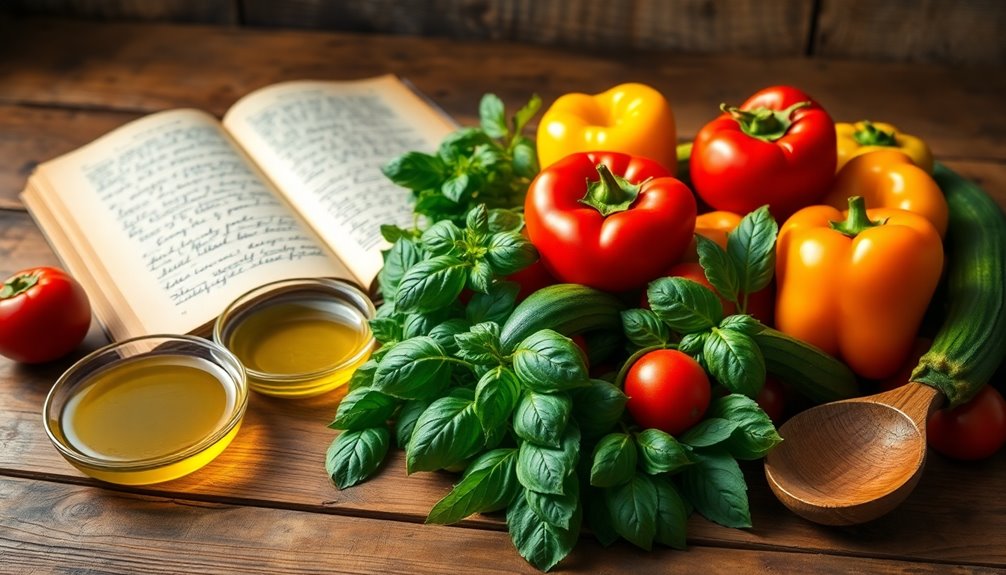
Baked vegetable pasta, often known as baked ziti, has a rich history rooted in Italian cuisine, where pasta has been a staple for centuries.
Baked vegetable pasta, a comforting dish with Italian roots, showcases the timeless appeal of pasta in a satisfying meal.
This hearty dish evolved as a practical way to use leftover pasta and vegetables, minimizing food waste while creating a satisfying meal. Traditional baked pasta recipes combine pasta with rich tomato sauce and various cheeses, often highlighting seasonal vegetables based on regional availability.
Its comfort food status has transcended Italy, becoming popular in many cultures, particularly in North America, where it graces family gatherings and potlucks.
Today, modern adaptations embrace healthier ingredients like whole grain or gluten-free pasta and a broader array of vegetables, catering to diverse dietary preferences while preserving its comforting essence.
Recipe

To begin, choose your favorite seasonal vegetables such as bell peppers, zucchini, and mushrooms. Roasting these vegetables enhances their natural flavors and brings out a wonderful caramelization that adds depth to the dish.
Combine the roasted vegetables with cooked pasta, ricotta, and marinara sauce, then bake until the dish is bubbling and the cheese is perfectly melted. This recipe is versatile, making it suitable for different dietary requirements by substituting dairy products or using gluten-free pasta if needed.
Ingredients:
- 8 oz pasta (penne or rigatoni)
- 2 cups seasonal vegetables (bell peppers, zucchini, mushrooms)
- 2 cups marinara sauce
- 1 cup ricotta cheese
- 1 cup shredded mozzarella cheese
- 1/2 cup grated Parmesan cheese
- 1 tablespoon olive oil
- Salt and pepper to taste
- Fresh basil for garnish (optional)
Instructions:
Preheat your oven to 375°F (190°C).
Begin by roasting the seasonal vegetables: toss them in olive oil, salt, and pepper, then spread them on a baking sheet and roast for about 20 minutes, or until tender and caramelized.
While the vegetables are roasting, cook the pasta according to package instructions until al dente.
In a large mixing bowl, combine the cooked pasta, roasted vegetables, ricotta cheese, and marinara sauce. Stir well to combine and transfer the mixture to a greased baking dish.
Top with shredded mozzarella and grated Parmesan cheese, then bake for 25-30 minutes, or until the cheese is melted and bubbly.
Extra Tips:
For the best flavor, be sure to roast the vegetables until they're nicely caramelized, as this enhances their sweetness. Incorporating seasonal vegetables into your meals not only boosts flavor but also provides essential nutrients.
Feel free to experiment with different types of vegetables based on what you have on hand or what's in season.
Additionally, if you have leftovers, store them in an airtight container in the fridge for up to five days. Reheat in the oven or microwave, and consider adding a splash of marinara sauce to keep it moist.
Enjoy your comforting baked vegetable pasta!
Cooking Steps
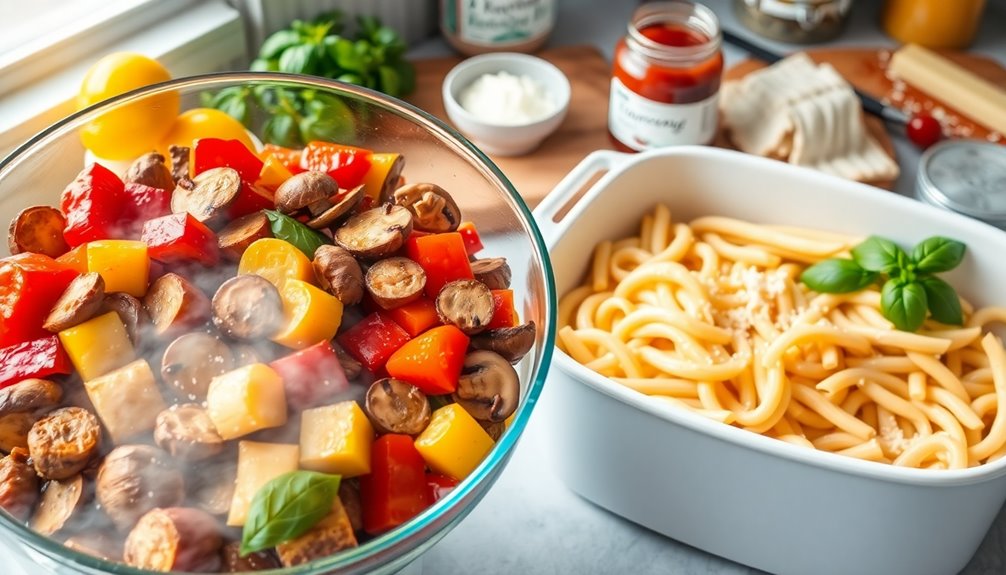
To get started, preheat your oven to 375°F and prepare for a delicious bake.
Next, mix your sautéed vegetables into the pasta, blending in a tasty cheese mix.
Once everything's combined, it's time to bake for 25 minutes and finish with a sprinkle of fresh herbs. This dish can be served alongside a hearty breakfast option like the Tomato Basil Farro Egg Bowl for a complete meal.
Step 1. Preheat Oven to 375°F
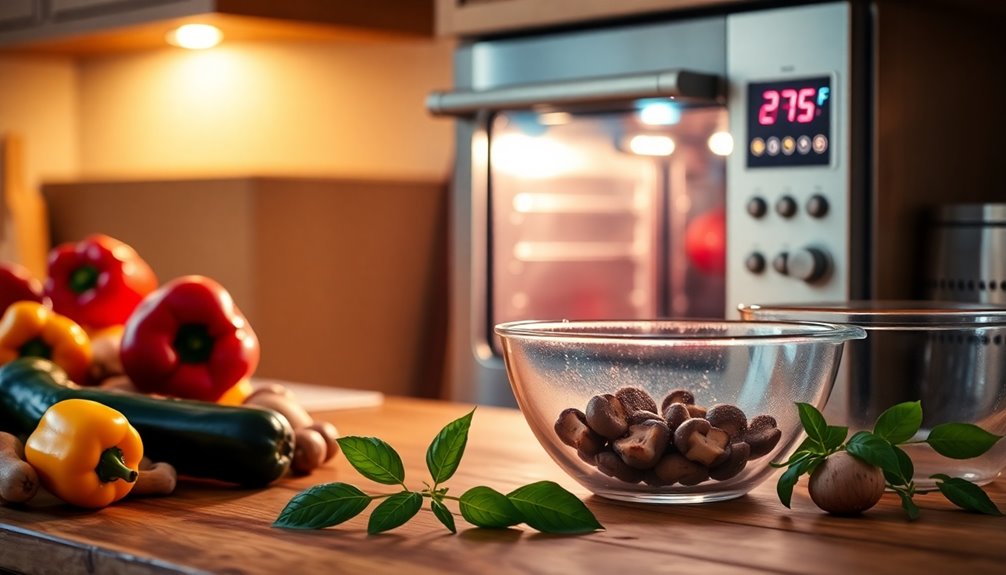
Preheating your oven to 375°F (190°C) is crucial for achieving perfectly baked vegetable pasta.
Start by turning on your oven and set it to the desired temperature. Allow it to heat for at least 15-20 minutes to ensure it reaches the optimal cooking temperature for even baking.
If accuracy is important, use an oven thermometer to confirm the temperature, as some ovens may vary.
Once preheated, place a greased baking dish or an oven-safe skillet on the middle rack to prevent burning the bottom of your pasta.
Keep an eye on your dish while it bakes, aiming for that bubbly, golden cheese topping, which typically takes about 20-25 minutes.
Enjoy the delicious outcome!
Step 2. Add Vegetables to Pasta Mix
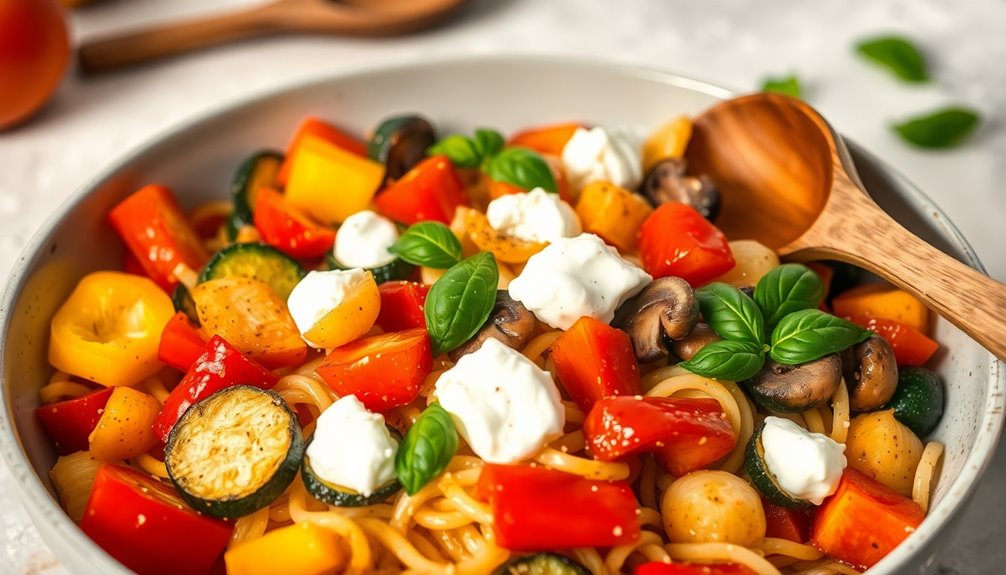
Adding a colorful mix of seasonal vegetables to your pasta not only boosts flavor but also enhances its nutritional value. Start by selecting vegetables like bell peppers, zucchini, and mushrooms. Slice them uniformly for even cooking and sauté in olive oil until softened and browned, about 5 to 10 minutes. Meanwhile, cook the pasta in salted boiling water, stopping just shy of al dente—about 2 minutes less than the package instructions. Once ready, combine the sautéed vegetables with the pasta, stirring in marinara sauce for added richness. It's important to note that baked kale can also be a delightful addition to this dish, offering essential nutrients and flavor. Including a variety of vegetables can also provide antioxidants that support overall health. Moreover, incorporating fermented vegetables can enhance the dish's nutritional profile and add a unique flavor dimension. Pour everything into a baking dish, ensuring it's well mixed. This vibrant combination will create a delicious base for the next steps in your baked vegetable pasta preparation.
Step 3. Mix in Cheese Blend
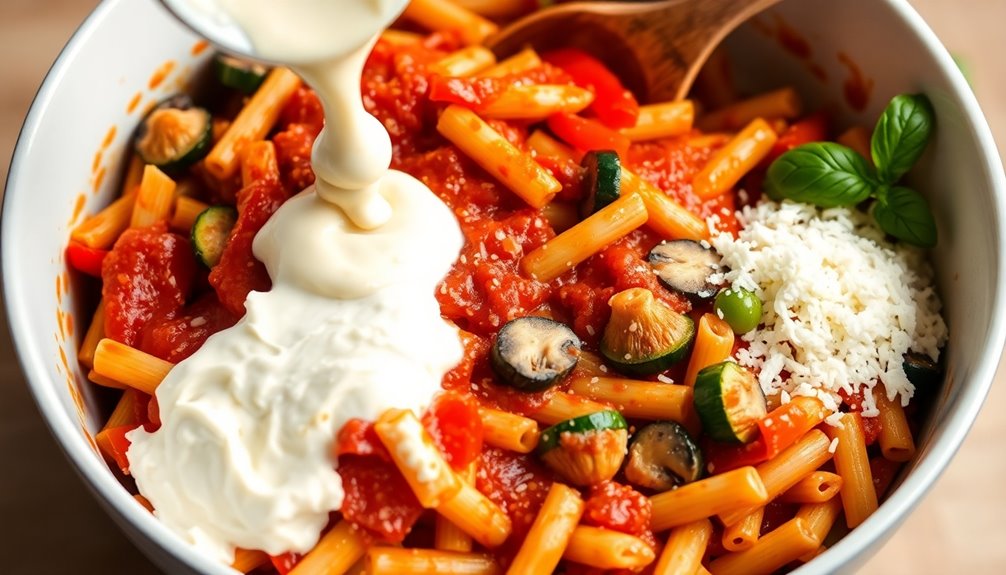
Once your sautéed vegetables and pasta are combined, it's time to elevate the dish by mixing in a creamy cheese blend.
Start by using a combination of ricotta, mozzarella, and parmesan cheese. Make sure these ingredients are at room temperature for better incorporation. Incorporating protein sources like beans or turkey can also enhance the nutritional value of your meal. Additionally, adding chia seeds can provide a boost in fiber and omega-3 fatty acids, enriching the overall health benefits of the dish.
Gently fold the cheese blend into the pasta and vegetable mixture, ensuring even distribution throughout. This not only enhances the flavor but also creates a rich, comforting consistency that complements the roasted vegetables.
For an extra flavor boost, consider adding fresh herbs like basil or a dash of garlic powder to the cheese blend. Additionally, you might want to serve this dish with a side of vegetable stew for a complete meal experience.
This step is crucial, as it sets the stage for a deliciously creamy texture in your baked vegetable pasta.
Step 4. Bake for 25 Minutes
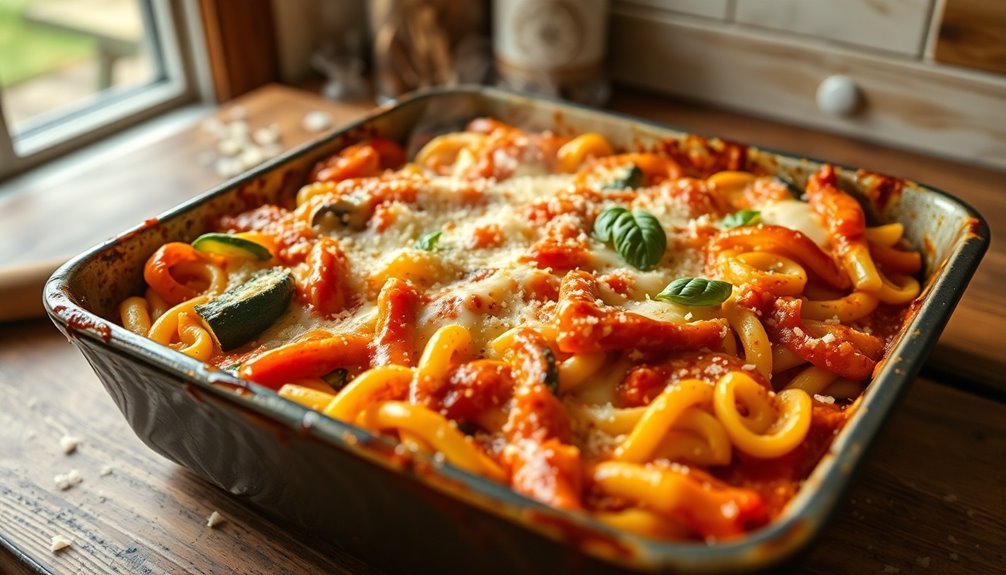
With the creamy cheese blend folded into your pasta and vegetables, it's time to get everything into the oven.
Preheat your oven to 350°F (175°C) to ensure even cooking. Once your pasta, sautéed vegetables, and sauce are combined, transfer the mixture to a greased baking dish. This step promotes optimal heat distribution, leading to perfectly baked goodness.
Now, bake the dish for about 20 to 25 minutes. Keep an eye out for a golden-brown topping, which signals that it's ready. This baking time allows the flavors to meld beautifully, enhancing the overall dish.
After it's done, let the baked vegetable pasta cool slightly before serving; it'll be easier to serve and taste even better!
Step 5. Garnish With Fresh Herbs
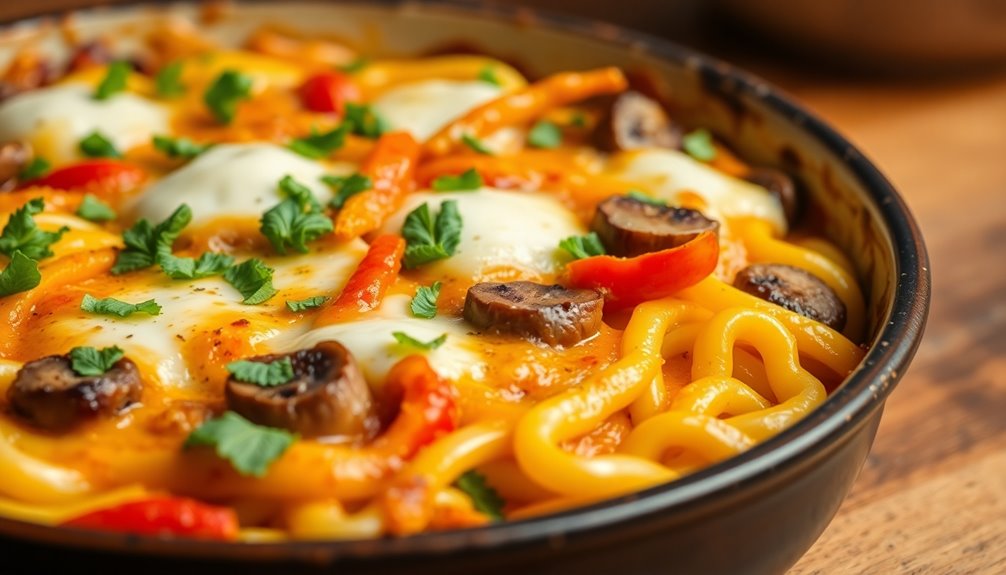
To elevate your baked vegetable pasta, consider garnishing it with fresh herbs just before serving. Fresh herbs like basil or parsley not only enhance the dish's flavor but also add a vibrant pop of color.
Remember to sprinkle chopped herbs right before you serve; cooking them can diminish their taste. You might also want to mix herbs like basil with oregano or thyme for a more complex flavor profile.
For an aromatic touch, lightly tear or bruise the fresh herbs to release their essential oils, intensifying the overall flavor experience.
This simple garnish will provide a delightful contrast to the rich, creamy texture of the pasta, making every bite even more enjoyable.
Final Thoughts
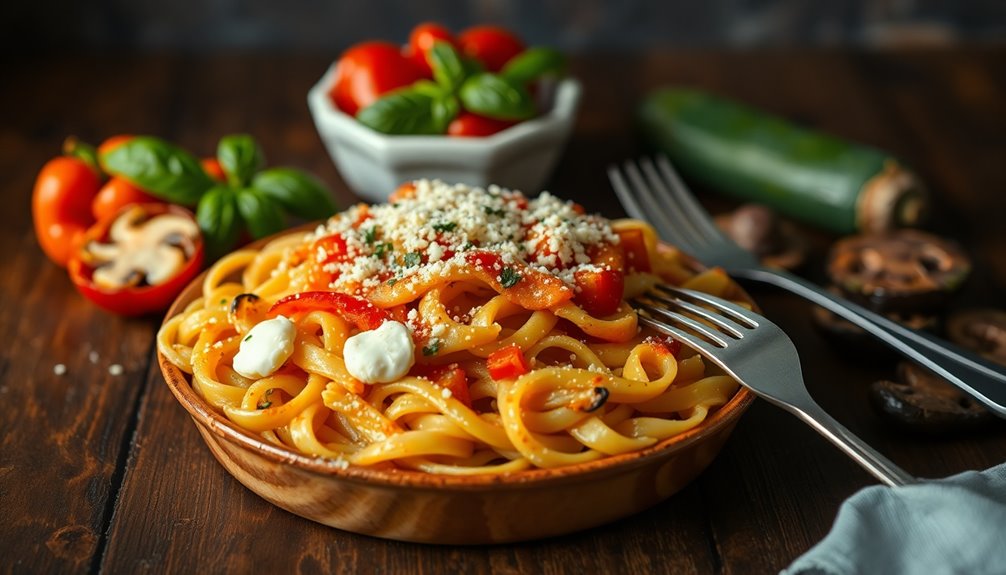
As you wrap up your meal planning, consider the many benefits of baked vegetable pasta. This versatile dish not only packs a flavor punch but also enhances nutrition by incorporating seasonal vegetables.
It's a family-loved favorite that transforms even picky eaters into veggie enthusiasts. You can customize the recipe to suit dietary restrictions, like using gluten-free pasta or dairy-free alternatives, ensuring everyone can enjoy it. Additionally, incorporating real estate IRAs into your financial planning can provide a solid foundation for future investments.
Plus, it's perfect for meal prep; you can make it in advance, refrigerate it for up to two days, or freeze it for a later date.
With its creamy texture and satisfying taste, baked vegetable pasta is a smart choice for any busy household. Additionally, pairing it with a cup of herbal tea can provide relaxation and aid digestion. Enjoy crafting this delightful dish!
Frequently Asked Questions
Do You Need to Boil Pasta Before Pasta Bake?
Yes, you should boil pasta before a pasta bake. Boiling it ensures even cooking and helps achieve that perfect al dente texture.
If you skip this step, the pasta might absorb too much sauce during baking, leading to a dry dish.
For sturdier pasta shapes like ziti or rigatoni, pre-cooking is crucial as it helps maintain their shape.
If you're using pasta designed for baking, adjust the sauce accordingly.
Is Vegetable Pasta Actually Healthy?
Think of vegetable pasta as a vibrant garden on your plate.
Yes, vegetable pasta can be quite healthy! It's packed with vitamins, minerals, and fiber, making it a nutritious alternative to traditional pasta.
When you choose varieties rich in whole grains, you're lowering calories and carbs, which helps if you're managing weight.
Plus, the added vegetables boost antioxidants, supporting your overall health and helping reduce inflammation.
It's a delicious way to nourish your body!
Can You Cook Pasta in the Oven Without Boiling It?
Yes, you can cook pasta in the oven without boiling it first! This method, known as oven-baked pasta, lets the pasta absorb moisture from the sauce while it cooks.
Just make sure you've got enough liquid—about 1.5 to 2 cups of sauce per 8 ounces of dry pasta.
Cover the dish with foil for the first half of baking to keep it moist, then uncover it for a nice golden top.
Enjoy!
What Type of Pasta Is Best for Bake?
When you're choosing the best type of pasta for baking, consider sturdy shapes like ziti, rigatoni, or penne.
These pastas hold their structure, absorb sauce beautifully, and create delicious, satisfying bites. You'll want to cook them al dente to ensure they don't become mushy.
For a healthier twist, try whole grain or gluten-free options that maintain texture while still delivering that comforting, baked goodness.
Your dish will benefit from your thoughtful choice!


